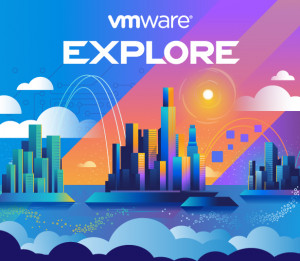
Brian Ducharme
Brian is an event reporter for VMBlog.com and an expert in virtualization/cloud techonlogies. In his 15+ years of experience in the virtualization/cloud field he has interviewed hundreds of companies, users and executives. Brian has been an active member of the NEVMUG (NEVTUG) since 2006 and attends both vmworld and Citrix Synergy every year. Brian works full time as a Senior Software Engineer for Liquidware Labs.
Brian also spent 5 years as the managing editor of Virtual Strategy Magazine, an online magazine focused on the virtualization industry and has been with vmblog since 2011. He has a background in Computer Graphics, Marketing, Programming, Web Design, Mobile App Development, Linux Administration and is an active member of the NHJS group.
Dell Technologies
Dell Technologies helps organizations and individuals build their digital future and transform how they work, live and play. The company provides customers with the industry’s broadest and most innovative technology and services portfolio for the data era.
Follow:
Twitter: https://twitter.com/DellStorage_HCI
LinkedIn: https://www.linkedin.com/company/delltechnologies
YouTube: https://www.youtube.com/channel/UC01FW5V9UVohbPtqKSmXX-w
Resources:
VxRail Whitepaper: www.delltechnologies.com/asset/en-us/products/converged-infrastructure/industry-market/idc-business-value-of-dell-vxrail-whitepaper.pdf.external
VxRail Infographic: https://www.delltechnologies.com/asset/en-us/products/converged-infrastructure/briefs-summaries/vxrail-vd4000-infographic.pdf.external
Product Page: www.dell.com/VxRail
Rubrik
Rubrik, the Zero Trust Data Security CompanyTM, delivers data resilience, data observability, and data recovery for organizations. Rubrik’s solutions keep your data safe and easy to recover in the face of cyber attacks and operational failures. Now you can recover the data you need, however and whenever you need it, to keep your business running. With Rubrik, your business becomes unstoppable.
Links:
Rubrik Website: https://www.rubrik.com/
Rubrik at VMware Explore: https://www.rubrik.com/company/events/vmware-explore
Follow Us:
Twitter: https://twitter.com/rubrikInc
LinkedIn: https://www.linkedin.com/company/rubrik-inc
Facebook: https://www.facebook.com/rubrikinc/
YouTube: https://www.youtube.com/channel/UCDoKLwlfdfH61rkzD3pu_ZQ
LG Business Solutions
LG Business Solutions has an expansive portfolio of IT solutions to support businesses across various industries including healthcare, retail, corporate, hospitality, airports, schools, and more. Key innovations include cloud computing, business laptops, projectors and desktop monitors.
Resources:
ControlUp
ControlUp helps IT resolve desktop issues faster, prevent tickets, and reduce spend by delivering a Digital Employee Experience (DEX) Management Fabric built for IT teams struggling with troubleshooting complex workspaces, support tickets, and flat budgets. With ControlUp, organizations minimize time spent troubleshooting with context-rich data and reporting, proactively identify problems while automating solutions before tickets are submitted, and consolidate tools into a single, easy-to-use web app.
Website: www.controlup.com
Twitter: https://twitter.com/ControlUp
LinkedIn: https://www.linkedin.com/company/controlup-technology/
Community: https://www.controlup.com/community/
Resources:
Trinks Case Study
Digital Employee Experience Management eBook
The dates are set, and the show is quickly approaching. Are you going to VMware Explore 2023, VMware’s flagship customer event for all things multi-cloud.
VMware Explore takes place August 21 – 24, 2023 at the Venetian Convention and Expo Center, Las Vegas, NV, and November 6 – 9 at the Fira Gran Via in Barcelona, Spain.
VMware Explore 2023 will host a community of technology users and leaders who all have a role in building the new multi-cloud world, including those engaged in enterprise applications, cloud architecture, infrastructure, end users, and networking and security.
The agenda includes thought leadership sessions, hands on training for new and popular technologies, and early access to the latest innovation announcements from VMware. And don’t forget about the fun and entertainment that is planned.
The content catalog is live. Explore it now!
Inside VeeamON 2023: Rick Vanover Explores Ransomware and New Inline Detection Capability
In this exclusive VeeamON 2023 video interview, VMblog sits down with Rick Vanover, senior director of product strategy at Veeam.
During our discussion, Rick explores the top picked breakout sessions as voted by VeeamON attendees: Microsoft 365, cloud, and ransomware. And then dives into the topic of ransomware, cybersecurity, and recovery. Rick also goes into more detail about the new upcoming inline detection capability, what it is and why it is important.
And make sure to go to: https://community.veeam.com/
In this exclusive VeeamON 2023 video interview, VMblog sits down with Shiva Pillay, the GM and SVP of Americas at Veeam, to discuss his new role of taking over the Americas. Prior to this change, Pillay was in charge of the AsiaPac and Japan (APJ) region for Veeam. Now, he will bring that same level of energy and success to the Americas.
Pillay tells VMblog that companies are facing many challenges in keeping their business running today. It is a far more complex IT environment that encompasses the cloud, SaaS and on-premises resources. At the same time, there’s a growing threat from cyberattacks as ransomware attacks continue to rise in frequency, affecting many organizations at least once. Veeam is focused on helping customers keep their business running by protecting their data and if the worst happens, helping them to recover rapidly.
The full Veeam 2023 Ransomware Trends Report is available for download at https://www.veeam.com/ransomware-trends-report-2023.
In this exclusive VeeamON 2023 interview, VMblog sits down with Dave Russell, the VP of Enterprise Strategies at Veeam, to discuss the new Veeam 2023 Ransomware Trends Report which was released during the event.
Looking at the ransomware trends, there is bad news and even worst news. As an example, according to the data in the report, one in seven organizations will see almost all (80%) data affected as a result of a ransomware attack - pointing to a significant gap in protection.
And paying the ransom does not ensure recoverability either. According to the study, while 59% paid the ransom and were able to recover data, 21% paid the ransom yet still didn't get their data back from the cyber criminals. Additionally, only 16% of organizations avoided paying ransom because they were able to recover from backups.
Russell discusses other study findings, and hopes that these findings help raise awareness across the industry. Veeam continues to add features and functionality into their products to help.
One other area of discussion that is important to consider is cyber insurance. What's interesting to note here is that while many companies have taken out and used cyber insurance in the past to help pay a ransom, many will find that this type of insurance may be going away.
The full Veeam 2023 Ransomware Trends Report is available for download at https://www.veeam.com/ransomware-trends-report-2023.
In the era of exponential data growth, organizations require robust and efficient solutions to manage and protect their valuable information. Backblaze, a leading provider of data storage and backup solutions, emerges as a key player in this space. In this exclusive VeeamON 2023 interview, VMblog sits down with Elton Carneiro, senior director of partnerships at Backblaze, to explore their cutting-edge technology and their strategic partnership with Veeam. Elton sheds light on the features and advantages of Backblaze's technology and how their collaboration with Veeam strengthens data management and protection.
Inside VeeamON 2023: Van Flowers Explores Cloudian's Object Storage Technology, Optimized for Veeam
In an era where data protection is paramount, Cloudian emerges as a leading force with its advanced object storage technology and immutability features. In this exclusive VeeamON 2023 interview, VMblog sits down with Van Flowers, senior systems engineer at Cloudian, as we explore the innovative solutions they offer. Flowers sheds light on Cloudian's object storage technology, its immutability capabilities, and how the strategic partnership with Veeam strengthens their data protection offerings. Additionally, Van provides a hands-on demo of their solution, showcasing its effectiveness in safeguarding valuable data.




